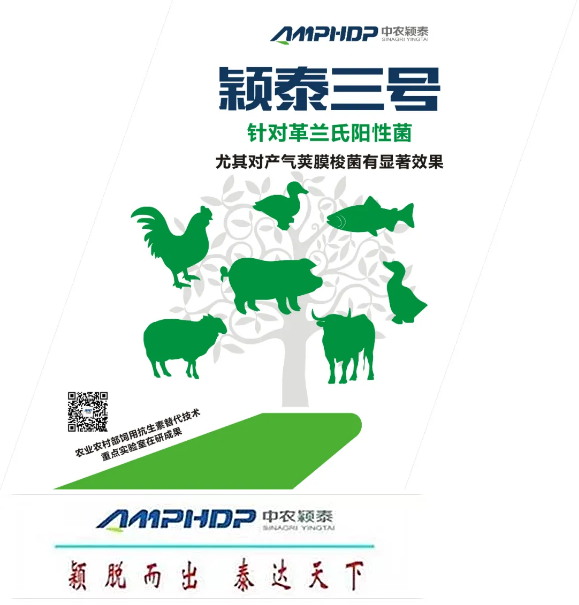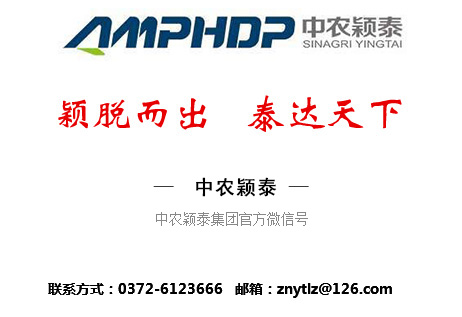On April 21, 2021, the Ministry of Agriculture and Rural Affairs of the People's Republic of China (MOA) issued the Technical Plan for Reducing corn and soybean Meal for Pig and Chicken Feed (hereinafter referred to as the "Plan"). This is a guiding technical document jointly formulated by the Animal Husbandry and Veterinary Bureau of the Ministry of Agriculture and Rural Affairs and the National Animal Nutrition Steering Committee, with the aim of broadening the source of feed raw materials, improving the utilization level, constructing a new ration formulation structure suitable for China's national conditions, and ensuring the effective supply of raw materials. The document is published in full on the Ministry of Agriculture's website, Open Government Information.
点击链接阅读和下载《猪鸡饲料玉米豆粕减量替代技术方案》:http://www.moa.gov.cn/gk/nszd_1/2021/202104/t20210421_6366304.htm

Why is it at the national level? What are the technical aspects of the scheme? How to use other materials to replace corn and soybean meal? This paper makes an interpretation of the scheme for the reference of feed and breeding enterprises.
I. Background of the "Plan"
In September 2020, The State Council issued the Opinions on Promoting high-quality Development of Animal Husbandry, specifically mentioning the need to adjust and optimize the feed formula structure and promote the reduction of corn and soybean meal replacement. NongCunBu so in March this year, agriculture animal husbandry and veterinary released about advancing the corn, soybean meal instead of reducing work notification, key issued in the feed corn, soybean meal instead of reducing work plan, to corn and corn to feed, the soybean meal miscellaneous meals instead of reducing, and clear the task partition and scheduling, to the end of march out of the formula, Set promotion goals by the end of April.
Two, why to improve the substitution of corn and soybean meal?
It is mainly a tight balance of corn and soybean meal.
China's animal husbandry, especially pig and chicken industry, is based on corn + soybean meal as the main feed material formula mode. China's current soybean meal consumption is about 75 million tons, corn feed consumption 190 million tons. However, China is heavily dependent on soybean imports. After 2015, annual soybean imports remained at more than 80 million tons, accounting for 60% of global soybean imports (Figure 1). Soybean meal is mainly used as feed material. Soybean production and soybean meal supply have become the "bottleneck" problem of animal husbandry. China's corn supply also has an annual supply gap of more than 20 million tons, corn prices are rising in recent years, high. The supply status of corn and soybean meal not only affects the profitability of aquaculture industry, but also affects the feed safety of China to a certain extent.
Therefore, the substitution of corn and soybean meal is urgent. According to calculation, if the proportion of soybean meal is reduced by 5%, theoretically the consumption of soybean meal can reduce 20 million tons, corresponding to reduce 25 million tons of imported soybeans, accounting for about 25% of China's soybean imports; In theory demand would fall by 57m tonnes if 30 per cent of feed corn were replaced by cereals. The implementation of "scheme" has strategic significance to improve the supply balance of feed industry in China.
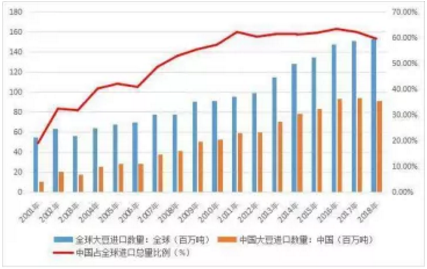
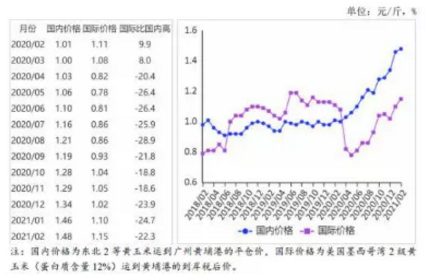
three. What are the suggestions of the "plan" on key points of daily ration preparation?
1. Determine the type of diet.
2. Set the effective energy level of daily diet reasonably.
3. Formulate a low protein diet based on available amino acids.
4. Consider the balance of other nutrients.
5. Reasonable selection and use of enzyme preparations.
6. Rational use of other additives.
What raw materials can replace corn? What to note?
See table 1.
Table 1. Common materials and alternatives to corn:
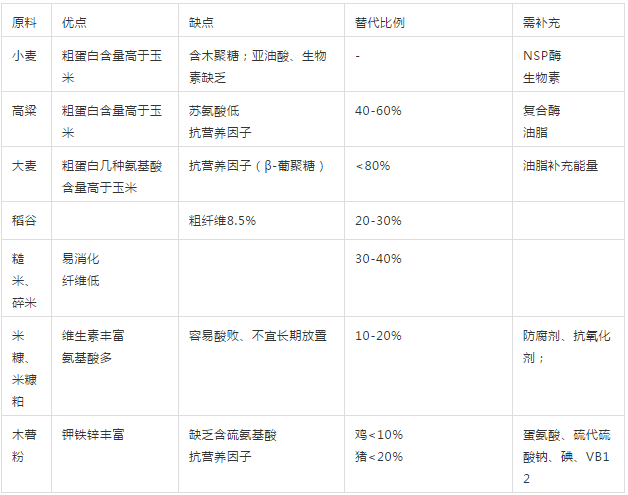
five ,What raw materials can replace soybean meal? What is the replacement ratio?
Are shown in table 2.
Table 2 Common materials and alternatives of soybean meal
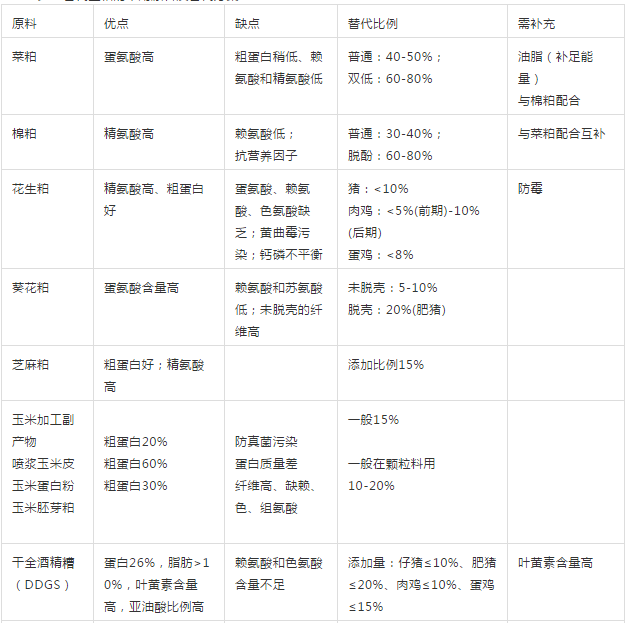

Vi. What should be paid attention to in the formulation design and use of alternative schemes?
In the process of feed processing, the following supporting measures should be paid attention to:
One is to do a good job of raw material pretreatment. The treatment of low value raw materials such as miscellaneous meal and residue by-products by means of biological fermentation or in vitro enzymatic hydrolysis can degrade anti-nutritional factors, increase beneficial microorganisms, produce part of organic acids and enzymes, realize nutrient predigestion, and increase the proportion of nutrients in feed.
Second, do a good job of processing alternative raw materials. Reasonable use of crushing, puffing, pelleting and other ways to treat raw materials, improve their nutritional value. In the process of processing, attention should be paid to the grinding size, mixing uniformity, feed hardness, etc., otherwise feed intake and production performance of animals will be affected. Wheat, barley, sorghum and other high viscosity, as far as possible rough breaking, when used in chicken feed should avoid excessive grinding caused by paste mouth phenomenon.
Three is in the daily grain production, the use of special grinder such as frequency conversion grinder, as far as possible to make the particle even, low powder rate, can use steam treatment disinfection feed.
In addition, pay attention to electrolyte balance, reasonable use of sodium source; The use of substitutes should be limited; Refueling setting transition period, timely observation of palatability and effect, and timely adjustment.
7. Feed materials in different regions are different, what are the differences in specific alternative schemes?
China's vast territory, different areas of the feed material difference. According to local conditions, the "program" made suitable alternative programs for growing and fattening pig feed in each region. As shown in the figure 3
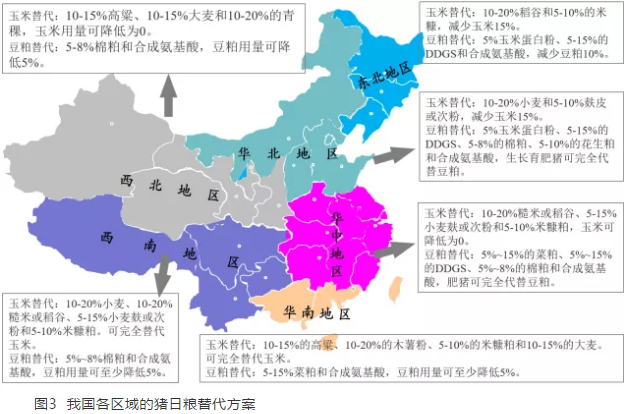
Eight, broiler feed corn and soybean meal reduction alternatives?
1. Replace corn with wheat and brown rice. Wheat and brown rice could completely replace corn in the diet of broiler chickens in the middle and late period, wheat accounted for 30%~40% of the total formula, brown rice accounted for 10%~15% of the total formula, and the amount of fresh rice bran could replace corn in the diet up to 20%. It is still recommended to add about 15% corn to chicken feed. When the amount of wheat is increased, the grain size of wheat should not be too fine (0.7mm ~ 0.9mm); No additional adhesive is required to granulate wheat rations, preventing the pellets from becoming too hard and reducing palatability and feed intake.
Wheat, barley and sorghum instead of corn. In the early period (1 to 21 days) of broiler chickens, wheat, barley and sorghum can be used together, and the substitution proportion of each raw material is not more than 30%, and the dosage of corn can be reduced to 0. In the late period (22-42 days) of broiler chickens, wheat, barley and sorghum can be used together. It is recommended that the replacement proportion of each raw material should not exceed 40%, and the dosage of corn should be reduced to 0. Using wheat and adding xylanase can completely replace corn in broiler diet.
3. Substitute soybean meal with miscellaneous meal and other protein materials. When 7% ~ 14% double low rapeseed meal was used to replace soybean meal in broiler diet, soybean meal consumption could be reduced by 6% ~ 10%. Using 2.5%-10.5% low phenol cottonseed meal instead of soybean meal in broiler diet can reduce the amount of soybean meal by 2%-10%. Soybean meal consumption could be reduced by 2% to 6% when 4% to 12% high-quality DDGS were used in broiler diets instead of soybean meal. Using 15% fresh peanut kernel cake instead of soybean meal in broiler diet, soybean meal consumption could be reduced by about 15%. The amount of pea in broiler diet at late growth stage can be up to 20%. By increasing amylose ratio to 0.35-0.5, dietary crude protein level could be reduced by 2%.
4. Soybean meal free diet formula. In the early diet of broilers, the amount of soybean meal could be reduced to 0 when corn gluten meal (up to 10%), rapeseed meal (up to 10%), cottonseed meal (up to 20%) and peanut meal (up to 10%) were used together. In the late diet of broilers, when corn gluten meal (up to 15%), rapeseed meal (up to 15%), cottonseed meal (up to 25%) and peanut meal (up to 10%) were used together, the amount of soybean meal could be reduced to 0.
nine. Substitution of corn and soybean meal reduction for laying hens?
Replace corn with wheat and brown rice. Wheat and brown rice could completely replace corn in the diets of laying hens at growing stage and laying stage under the condition of adding oil and enzyme preparation. A combination of wheat and brown rice is recommended to replace 40 to 60 percent of corn with less than 20 percent of corn. When wheat and brown rice replace corn in the egg-laying diet, pigment needs to be added. It is recommended to keep 20% corn in the diet of laying hens during the incubation period.
Wheat, barley and sorghum instead of corn. When the mixture of wheat, barley or sorghum is used in the diet of laying hens, the amount of corn can be reduced to about 15%. The amount of wheat, barley and sorghum in the diet of laying hens can be up to 40%, and the amount of corn can be reduced to 0 by combining with and adding the corresponding enzyme preparation. Pigment needs to be added in the diet of laying hens during laying period.
3. Substitute soybean meal with miscellaneous meal and other protein materials. Cottonseed meal and rapeseed meal can be used separately or in combination to replace soybean meal in the diet of laying hens during the incubation period. It is suggested that the replacement proportion should not exceed 5% and the amount of soybean meal should be maintained at more than 15%. Cottonseed meal, rapeseed meal, sunflower meal and rice bran meal can be used to replace soybean meal in the diet of laying hens during the growing period. The recommended dosage of each miscellaneous meal is 5%-8%, and the dosage of soybean meal can be replaced by about 15%. Cottonseed meal, rapeseed meal (8%-10% each) and corn gluten meal (3%-5%) could be used to replace soybean meal in laying diet, and the amount of soybean meal could be reduced to less than 8%.
4. Soybean meal free diet formula. When laying hens were fed with corn gluten meal (up to 5%), rapeseed meal (up to 15%), cottonseed meal (up to 10%), peanut meal (up to 10%), sunflower meal (up to 8%) and palm kernel meal (up to 5%), the amount of soybean meal could be reduced to 0.
